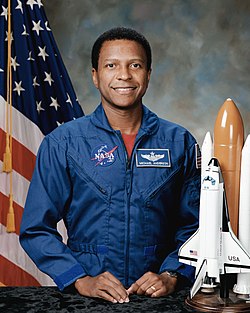Michael P. Anderson
- För filmregissören, se Michael Anderson (regissör). För andra personer med liknande namn, se Michael Andersson.
| Michael Philip Anderson | |
 | |
| NASA-astronaut | |
|---|---|
| Född | 25 december 1959 Plattsburgh, New York, |
| Död | 1 februari 2003 (43 år) Ovanför Texas, USA |
| Tid i rymden | 24 dagar, 18 timmar, 8 minuter |
| Urvalsgrupp | Astronautgrupp 15 |
| Uppdrag | STS-89, STS-107 |
| Uppdragsemblem | |
| Utmärkelser | |
Michael Philip Anderson, född 25 december 1959 i Plattsburgh, New York, död 1 februari 2003 ovanför Texas, var en amerikansk astronaut uttagen i astronautgrupp 15 den 9 december 1994. Han deltog i rymdfärjan Columbias sista uppdrag, STS-107, 16 januari-1 februari 2003, under vilket alla sju astronauterna ombord förolyckades under återinträdet i jordens atmosfär.
Eftermäle
2004 tilldelades han Congressional Space Medal of Honor.
2006 namngavs månkratern M. Anderson efter honom, kratern är belägen i Apollokratern på månens baksida.
Även asteroiden 51824 Mikeanderson är uppkallad efter honom.[1]
Familjeliv
Han hade fru och barn.
Rymdfärder
Källor
”Biographical Data” (på engelska) (PDF). NASA. maj 2004. https://www.nasa.gov/wp-content/uploads/2016/01/anderson_michael.pdf?emrc=6e26e7. Läst 11 maj 2024.
- ^ ”Minor Planet Center 51824 Mikeanderson” (på engelska). Minor Planet Center. https://www.minorplanetcenter.net/db_search/show_object?object_id=51824. Läst 7 september 2018.
Media som används på denna webbplats
* In the STS-89 crew insignia, the link between the United States and Russia is symbolically represented by the Space Shuttle Endeavour and Russia's Mir Space Station orbiting above the Bering Strait between Siberia and Alaska. The success of the joint United States-Russian missions is depicted by the Space Shuttle and Mir colored by the rising sun in the background.
- A shadowed representation of the International Space Station (ISS) rising with the sun represents the future program for which the Shuttle-Mir missions are prototypes. The inside rim of the insignia describes the outline of the number eight representing STS-89 as the eighth Shuttle/Mir docking mission.
- The nine stars represent the nine joint missions to be flown of the program and when combined with the number eight in the rim, reflect the mission number. The nine stars also symbolize the children of the crew members who will be the future beneficiaries of the joint development work of the space programs of the two countries.
- Along the rim are the crew members' names with David A. Wolf's name on the left and Andrew S. W. Thomas' name on the right, the returning and upgoing cosmonaut guest researcher crew members. In between and at the bottom is the name of Salizan S. Sharipov, payload specialist representing Russian Space Agency (RSA), in Cyrillic alphabet.
- The other crew members are Terrence W. Wilcutt, commander; Joe F. Edwards, Jr., pilot; and mission specialists Michael P. Anderson, Bonnie J. Dunbar, and James F. Reilly. The red, white and blue of the rim reflect the colors of the American and Russian flags which are also represented in the rim on either side of the joined spacecraft.
Astronaut Michael P. Anderson, payload commander. Died during the failed re-entry attempt of the Space Shuttle Columbia.
STS107-S-001 (May 2001) This is the insignia for w:STS-107, which is a multi-discipline microgravity and Earth science research mission with a multitude of international scientific investigations conducted continuously during the planned 16 days on orbit. The central element of the patch is the microgravity symbol, µg, flowing into the rays of the astronaut symbol. The mission inclination is portrayed by the 39 degree angle of the astronaut symbol to the Earth's horizon. The sunrise is representative of the numerous experiments that are the dawn of a new era for continued microgravity research on the International Space Station and beyond. The breadth of science conducted on this mission will have widespread benefits to life on Earth and our continued exploration of space illustrated by the Earth and stars. The constellation Columba (the dove) was chosen to symbolize peace on Earth and the Space Shuttle Columbia. The seven stars also represent the mission crew members and honor the original astronauts who paved the way to make research in space possible. The Israeli flag is adjacent to the name of the payload specialist who is the first person from that country to fly on the Space Shuttle.




